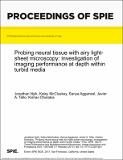Probing neural tissue with airy light-sheet microscopy : investigation of imaging performance at depth within turbid media
Abstract
Light-sheet microscopy (LSM) has received great interest for fluorescent imaging applications in biomedicine as it facilitates three-dimensional visualisation of large sample volumes with high spatiotemporal resolution whilst minimising irradiation of, and photo-damage to the specimen. Despite these advantages, LSM can only visualize superficial layers of turbid tissues, such as mammalian neural tissue. Propagation-invariant light modes have played a key role in the development of high-resolution LSM techniques as they overcome the natural divergence of a Gaussian beam, enabling uniform and thin light-sheets over large distances. Most notably, Bessel and Airy beam-based light-sheet imaging modalities have been demonstrated. In the single-photon excitation regime and in lightly scattering specimens, Airy-LSM has given competitive performance with advanced Bessel-LSM techniques. Airy and Bessel beams share the property of self-healing, the ability of the beam to regenerate its transverse beam profile after propagation around an obstacle. Bessel-LSM techniques have been shown to increase the penetration-depth of the illumination into turbid specimens but this effect has been understudied in biologically relevant tissues, particularly for Airy beams. It is expected that Airy-LSM will give a similar enhancement over Gaussian-LSM. In this paper, we report on the comparison of Airy-LSM and Gaussian-LSM imaging modalities within cleared and non-cleared mouse brain tissue. In particular, we examine image quality versus tissue depth by quantitative spatial Fourier analysis of neural structures in virally transduced fluorescent tissue sections, showing a three-fold enhancement at 50 μm depth into non-cleared tissue with Airy-LSM. Complimentary analysis is performed by resolution measurements in bead-injected tissue sections.
Citation
Nylk , J , McCluskey , K , Aggarwal , S , Tello , J A & Dholakia , K 2017 , Probing neural tissue with airy light-sheet microscopy : investigation of imaging performance at depth within turbid media . in T G Brown , C J Cogswell & T Wilson (eds) , Three-Dimensional and Multidimensional Microscopy : Image Acquisition and Processing XXIV . , 100700B , Proceedings of SPIE , vol. 10070 , SPIE , pp. 1-7 , Three-Dimensional and Multidimensional Microscopy: Image Acquisition and Processing XXIV 2017 , San Francisco , California , United States , 30/01/17 . https://doi.org/10.1117/12.2251921 conference
Publication
Three-Dimensional and Multidimensional Microscopy
ISSN
1605-7422Type
Conference item
Description
Funding: UK Engineering and Physical Sciences Research Council under grant EP/J01771X/1 (KD), the 'BRAINS' 600th anniversary appeal, and Dr. E. Killick; The Northwood Trust and The RS Macdonald Charitable Trust (JAT); Royal Society Leverhulme Trust Senior Fellowship (KD).Collections
Items in the St Andrews Research Repository are protected by copyright, with all rights reserved, unless otherwise indicated.

